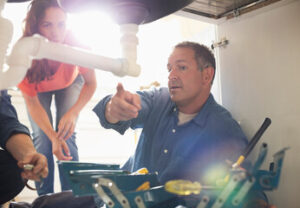The Importance of Plumbing in Residential Buildings
In any residential building design, plumbing is one of the most important systems. It supplies fresh water to appliances and removes waste solid or liquid from the building. It is also important for the health and comfort of occupants.

Westfield Plumbing drawings are technical diagrams that illustrate the layout and design of a plumbing system in a structure. These drawings are used for construction purposes and are usually created by professional engineers or designers.
A plumbing system is made up of pipes, fixtures, and appliances that provide drinking water and remove waste. This vital infrastructure relies on gravity and pumps to move water around, but it’s the pipes that carry the bulk of the load. Pipes are built to withstand high pressure and must be able to handle a wide range of temperatures. They also need to be resistant to corrosion and damage. This has led to the development of a number of different types of pipes, each with their own benefits and drawbacks.
The pipes in your home are likely made of copper, PVC, or PEX. The latter is a flexible plastic that’s gained popularity in modern plumbing because it’s affordable and durable. It’s also easy to work with, so plumbers can bend and weave it into tight spaces. In addition to its flexibility, PEX is resistant to scale and chlorine, making it a popular choice for residential plumbing tubing.
Most plumbers work with a variety of materials, but they must meet specific performance and quality standards to be licensed by governing bodies. In addition, they must pass a background check and take continuing education courses to keep up with new technology and installation methods. In Canada, this includes undergoing training through the Industry Training Authority or Ontario College of Trades.
There are several different types of plumbing fixtures, but the most important ones are the drains, toilets, and bathtubs. These fixtures are used for bathing, washing, and cooking, and must be installed with the proper vents to prevent backflow. They must also be sized appropriately for the space they’re in to avoid overflowing or flooding.
Another crucial type of fixture is the water heater, which is responsible for heating and storing water in your home. It’s important to choose a water heater that’s energy efficient, so you can save money on your utility bills. A professional can help you select the right size and model for your home.
Lastly, there are the drainage systems, which transport wastewater and vent gasses to the sewer system. These must be designed to accommodate varying water pressures and temperatures, and they should be equipped with deep seal traps. They can also include a single stack venting system, which is cheaper and easier to maintain than a multi-stack system.
Installation
Plumbing is a complex network of pipes that carry clean water into buildings and remove waste. It is essential for human life, but it can also be hazardous if it’s not functioning properly. A faulty plumbing system can lead to water damage, mold growth, and health hazards. Regular maintenance and repairs can help prevent these problems.
Plumbing installation is an important part of new construction projects. It involves laying the pipes for waste removal and water supply, as well as connecting them to appliances like sinks and toilets. Plumbers must follow building codes and regulations to ensure safe installations. They may also need to work with other professionals, such as engineers and architects.
In new construction, the plumbers first set the sewer accommodation stubs before the concrete foundation is poured. Then, they install the water lines in the slab, which includes hot and cold water lines. These lines are typically made of copper or plastic, and they run throughout the house to connect all the fixtures. Plumbers then connect the sewer line to the home’s septic tank or municipal waste management system. They make sure that all drains are wet vented, and they check that the main stack is in the right place.
Other types of plumbing installations include gas and drain lines. Gas lines bring in natural gas to heat homes and cook food. They are usually installed along with the kitchen appliances, such as stoves and refrigerators. Drain lines carry wastewater out of the home and into the sewer system or septic tank. Plumbers must be careful when installing these lines, as they must follow strict regulations to avoid leaks and other issues.
In addition to these major installations, plumbers often perform small repairs and maintenance tasks. They can repair or replace damaged parts, such as faucets and shower heads. They can also fix leaks and clogs. In some cases, they may need to change out whole sections of pipe, which requires cutting and replacing them with new ones. Plumbing is a complicated job that requires a lot of training and experience to do correctly. It is essential for a healthy, functioning building, and it should be maintained regularly to avoid expensive repairs in the future.